 Image search results - "ishiyama-dera" Image search results - "ishiyama-dera" |

Ishiyama-dera temple is a 10-min. walk from Ishiyama-dera Station on the Keihan Ishisaka Line. You can transfer to the Keihan Line at JR Ishiyama Station on the Tokaido Line.
|
|

During early or mid-April, you can see cherry blossoms while walking from the station to the Ishiyama-dera along the Seta River.
|
|

Cherry blossoms along Seta River in Otsu, Lake Biwa's only outflowing river.
|
|

Cherry trees also greet you at the temple.
|
|

Ishiyama-dera stone marker during sakura season in April.
|
|

Impressive San-mon Gate, also called Todaimon. The defacto front gate of the temple. 東大門 MAP
|
|

San-mon Gate Deva King (right side).
|
|

San-mon Gate Deva King (left side)
|
|

Path to Ishiyama-dera in autumn.
|
|

As of spring 2023, Ishiyama-dera's head priest is a woman, the 53rd zasu abbot. Washio Ryuge (鷲尾龍華) is Ishiyama-dera's first woman abbot taking over from her father who preceded her. She's in her mid-30s..
|
|
|
|

After passing through Todamon Gate, there is the Sando path leading to the temple complex. See fall leaves in Nov. 参道
|
|

The Sando path also has cherry trees in April. Late April brings azaleas.
|
|
|
|
|
|
|

Waterwheel
|
|

Go up the stone steps and pass by a Shinto shrine.
|
|

This is what you see at the top of the stone steps. Founded in 749, Ishiyama-dera, belonging to the Shingon Buddhist Sect, is the 13th Temple of the Saigoku Pilgrimage.
|
|

Straight ahead is the huge slab of black stone which gave the temple its name. Ishiyama-dera means "Stone Mountain Temple." The pagoda above is the Tahoto, a National Treasure and positioned perfectly for our line of sight from below.
|
|

Ishiyama-dera's stone is wollastonite (硅灰石) which looks gray or white when dry and black when wet. Tahoto pagoda can also be seen.
|
|

Ishiyama-dera's stone is a National Natural Monument.
|
|
|
|

Cherry blossoms and Tahoto pagoda at Ishiyama-dera.
|
|
|
|

The stone in fall.
|
|
|

Closeup of the stone, designated as a Natural Monument.
|
|
|
|
|

One-yen coins are stuffed into the cracks of the stone.
|
|
|

Sign explaining the Natural Monument.
|
|

Ishiyama-dera is a temple complex of numerous buildings. This is the Kannon-do Hall.
|
|

The Kannon-do Hall stores many Kannon statues.
|
|

Next to the Kannon-do is the Bishamon-do Hall.
|
|

Bishamon-do Hall was built in 1773. 毘沙門堂
|
|

Inside Bishamon-do Hall is Bishamon.
|
|

Omido Hall 御影堂
|
|

Mieido Hall dedicated to Kobo Daishi who founded Shingon Sect, to Roben 良弁僧正, the founder of Ishiyama-dera, and to Shunnyu Naiku 淳祐内供, the third head priest of Ishiyama-dera. 御影堂
|
|
|
|
|

Plum blossoms.
|
|

Rennyo-do Hall, dedicated to Rennyo, prominent priest of the Jodo Shinshu Sect. 蓮如堂
|
|

Inside Rennyo-do Hall.
|
|

Steps going to the Hondo Hall, Ishiyama-dera's main worship hall and a National Treasure.
|
|

Ishiyama-dera's Hondo Hall, a National Treasure. 本堂
|
|
|

Inside Ishiyama-dera's Hondo Hall 本堂
|
|

Inside Ishiyama-dera's Hondo Hall 本堂
|
|

Ishiyama-dera's Hondo Hall altar. 本堂
|
|
|
|

From March 18 to Dec. 4, 2016, Ishiyama-dera held a special display of their hidden Buddha. Shown only once every 33 years.
|
|

Hondo main temple hall
|
|
|

Inside Hondo
|
|
|
|

Admission was charged to see the hidden Buddha.
|
|

This smaller Buddha was used to obstruct the view of the hidden Buddha from non-paying visitors.
|
|

The line to see the hidden Buddha.
|
|

It didn't that long to see the hidden Buddha.
|
|

Ishiyama-dera's hidden, giant Buddha (Kannon) is visible through the altar.
|
|

Normally, you cannot see this Buddha through the altar since the Buddha is housed behind closed doors. We were allowed to walk behind the altar to see the giant Buddha in its shelter with the doors open. A large, impressive Buddha. No photos were allowed.
|
|

The large, hidden Buddha also had smaller Kannon statues inside. These were also displayed.
|
|

Ishiyama-dera's Hondo Hall 本堂
|
|

View of fall leaves below Hondo Hall 本堂
|
|

Ema votive tablets on which you write your prayers and wishes.
|
|

The Hondo also has this Room of Genji.
|
|

Room of Genji
|
|

Room of Genji (源氏の間)
|
|

At Ishiyama-dera, inside Room of Genji is a lifesize doll of Lady Murasaki Shikibu who in the 11th century wrote Tale of Genji, one of Japan's most famous novels.
|
|

After staying in the temple for seven days, this is the room where Lady Murasaki Shikibu got inspired by an autumn moonlit night and started writing Genji Monogatari.
|
|

Ema prayer tablet
|
|

Omikuji paper fortunes
|
|
|

Hondo
|
|

At Ishiyama-dera, inside Room of Genji is a lifesize doll of Lady Murasaki Shikibu who wrote Tale of Genji, one of Japan's most famous novels.
|
|

Lady Murasaki supposedly wrote the novel in this room at Ishiyama-dera in Otsu.
|
|
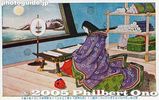
Lady Murasaki on a postcard.
|
|

View as we head toward the Tahoto pagoda.
|
|

In fall
|
|

In winter. The Omido Hall is on the left, and Bishamon-do on the right.
|
|
|
|
|
|
|
|
|

Torii at a Buddhist temple
|
|
|

Bell tower 鐘楼
|
|

During Ishiyama-dera's display of the hidden Kannon Buddha, they also allowed the public to ring the temple bell for a small fee.
|
|

During Ishiyama-dera's display of the hidden Kannon Buddha, they also allowed the public to ring the temple bell for a small fee.
|
|

Ishiyama-dera's bell
|
|

Moss on roof
|
|

Sutra Repository 経蔵
|
|

If you're a woman and sit on the rock under the Sutra Repository, you"re supposed be able to give birth safely. So don't be surprised to see a woman sitting under the building.
|
|

Sit on the rock under the Sutra Repository,
|
|

Finally we see Ishiyama-dera's beautiful Tahoto pagoda, a National Treasure in Otsu.
|
|

Tahoto's ground floor has a dome-shaped ceiling and a square pent roof, a round second floor and square roof.
|
|
|
|
|

Tahoto pagoda, Ishiyama-dera
|
|
|
|
|
|

A Tahoto pagoda has two stories, a square roof, and a round building. 多宝塔
|
|
|

The Tahoto was built in 1194 upon the patronage of Minamoto Yoritomo. It is Japan's oldest Tahoto and one of the three most famous ones.
|
|
|
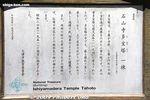
About the Tahoto
|
|

Tahoto in autumn
|
|
|
|

Inside the Tahoto is this altar for Dainichi Nyorai. 大日如来
|
|

Inside the Tahoto is this altar for Dainichi Nyorai. 大日如来
|
|

Inside the Tahoto is this altar for Dainichi Nyorai. 大日如来
|
|

Dainichi Nyorai. 大日如来
|
|
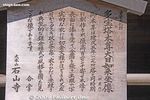
About the altar inside the Tahoto.
|
|

Memorials next to Tahoto dedicated to Minamoto Yoritomo and Kamegayatsu. 源頼朝 亀ケ谷禅尼
|
|
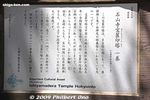
About the memorials.
|
|

Ishiyama-dera is also noted for autumn leaves.
|
|
|
|
|
|
|

Ishiyama-dera's Moon-viewing Pavilion and cherry blossoms. Not open to the public. 月見亭
|
|
|
|

Hall to Moon-viewing Pavilion.
|
|

View of Seta River in spring from Ishiyama-dera. Ahead is Lake Biwa.
|
|

The bridges are for the highway and shinkansen trains.
|
|
|

In fall.
|
|
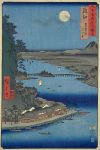
Hiroshige's woodblock print of Ishiyama-dera from his "Famous Views of the 60 Provinces" series. Looking toward Lake Biwa.
|
|

Hiroshige's woodblock print of Autumn Moon at Ishiyama from his "Omi Hakkei" (Eight Views of Omi) series. The temple on stilts and Moon-viewing Pavilion is visible.
|
|

Hiroshige's woodblock print of Autumn Moon at Ishiyama from his "Omi Hakkei" (Eight Views of Omi) series. The Moon-viewing Pavilion is visible.
|
|
|
|
|

Lots of autumn colors in Ishiyama-dera.
|
|
|
|
|

心経堂
|
|
|

心経堂
|
|

Ishiyama-dera also has a grove of plum blossoms which bloom in Feb.
|
|
|
|
|

Plum tree
|
|

Plum blossoms
|
|
|

Ishiyama-dera's weeping cherries and azalea bushes to bloom in late April.
|
|
|
|
|
|
|
|
|
|

Early-blooming cherry blossoms.
|
|

Statue of Lady Murasaki Shikibu.
|
|
|
|
|
|
|

豊浄院 temple museum
|
|

Inside 豊浄院
|
|
|
|
|
|
|
|
|

Needs a new paint job.
|
|

Statue of Lady Murasaki writing Tale of Genji (Genji Monogatari).
|
|

Statue of Lady Murasaki writing Tale of Genji (Genji Monogatari) at Ishiyama-dera buddhist temple
|
|

Statue of Lady Murasaki writing Tale of Genji (Genji Monogatari).
|
|

Statue of Lady Murasaki writing Tale of Genji (Genji Monogatari).
|
|

Statue of Lady Murasaki writing Tale of Genji (Genji Monogatari).
|
|

Japanese garden
|
|
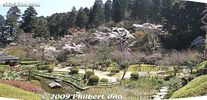
Ishiyama-dera's Japanese garden in spring.
|
|
|
|
|

Ishiyama-dera Hondo Hall, a National Treasure.
|
|
|
|
|
|

In fall
|
|

Ishiyama-dera in fall
|
|
|
|

Fall leaves on a rock formation.
|
|

Map of Ishiyama-dera
|
|

Keihan Ishiyama Station
|
|

Keihan Line at Ishiyama Station.
|
|

Inside Keihan Line train.
|
|

Keihan Line at Ishiyama Station.
|
|
|
|
|